Management Accounting Report: Costing and Budgeting for Imda Tech
VerifiedAdded on 2020/02/03
|14
|3916
|44
Report
AI Summary
This report provides a detailed analysis of management accounting principles and their application to Imda Tech Ltd (UK). It begins with an introduction to management accounting, differentiating it from financial accounting, and highlighting its importance in managerial decision-making. The report then explores various management accounting systems, including cost accounting, inventory management, job costing, and price optimization. It presents income statements using both absorption and marginal costing methods, providing a comparative analysis of these techniques. Furthermore, the report examines different types of budgets, their advantages, and disadvantages, along with the budgeting process itself. Pricing strategies are also discussed. The report concludes with an examination of the balance scorecard and performance measures, both financial and non-financial, and offers insights into improving financial governance and developing effective strategies for the company. This report provides a comprehensive overview of management accounting concepts and their practical application.
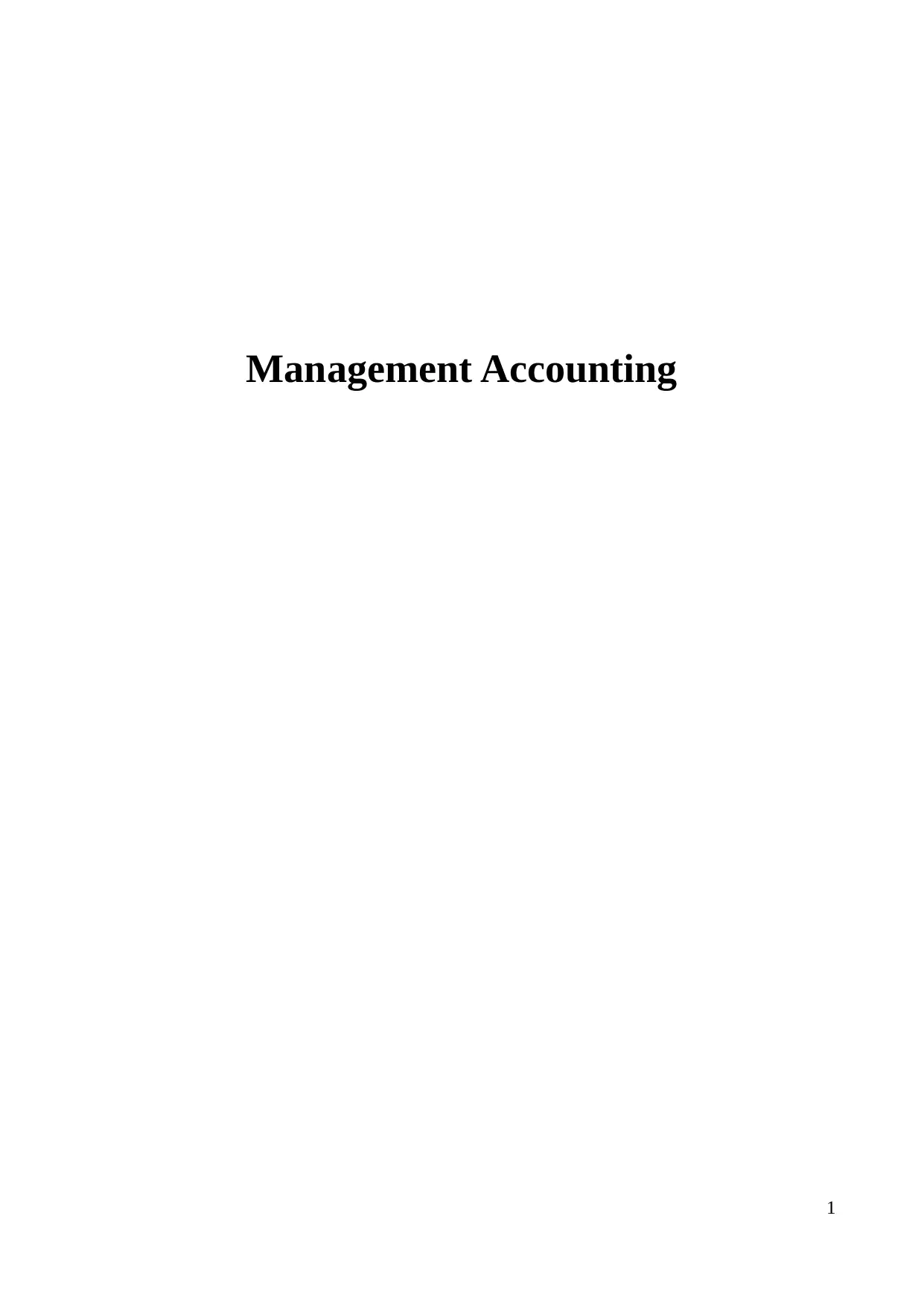
Management Accounting
1
1
Paraphrase This Document
Need a fresh take? Get an instant paraphrase of this document with our AI Paraphraser
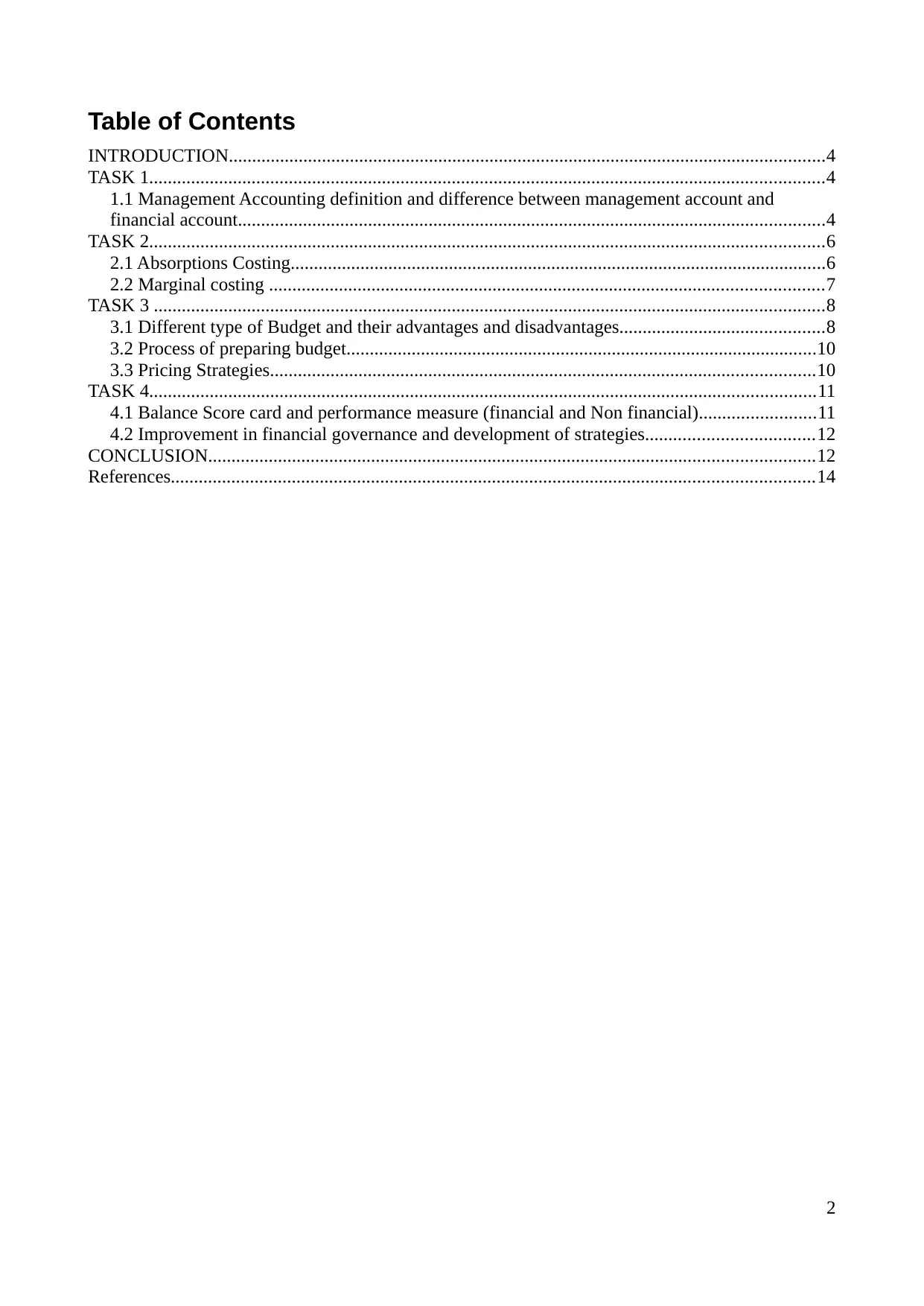
Table of Contents
INTRODUCTION................................................................................................................................4
TASK 1.................................................................................................................................................4
1.1 Management Accounting definition and difference between management account and
financial account..............................................................................................................................4
TASK 2.................................................................................................................................................6
2.1 Absorptions Costing...................................................................................................................6
2.2 Marginal costing .......................................................................................................................7
TASK 3 ................................................................................................................................................8
3.1 Different type of Budget and their advantages and disadvantages............................................8
3.2 Process of preparing budget.....................................................................................................10
3.3 Pricing Strategies.....................................................................................................................10
TASK 4...............................................................................................................................................11
4.1 Balance Score card and performance measure (financial and Non financial).........................11
4.2 Improvement in financial governance and development of strategies....................................12
CONCLUSION..................................................................................................................................12
References..........................................................................................................................................14
2
INTRODUCTION................................................................................................................................4
TASK 1.................................................................................................................................................4
1.1 Management Accounting definition and difference between management account and
financial account..............................................................................................................................4
TASK 2.................................................................................................................................................6
2.1 Absorptions Costing...................................................................................................................6
2.2 Marginal costing .......................................................................................................................7
TASK 3 ................................................................................................................................................8
3.1 Different type of Budget and their advantages and disadvantages............................................8
3.2 Process of preparing budget.....................................................................................................10
3.3 Pricing Strategies.....................................................................................................................10
TASK 4...............................................................................................................................................11
4.1 Balance Score card and performance measure (financial and Non financial).........................11
4.2 Improvement in financial governance and development of strategies....................................12
CONCLUSION..................................................................................................................................12
References..........................................................................................................................................14
2

3
⊘ This is a preview!⊘
Do you want full access?
Subscribe today to unlock all pages.

Trusted by 1+ million students worldwide
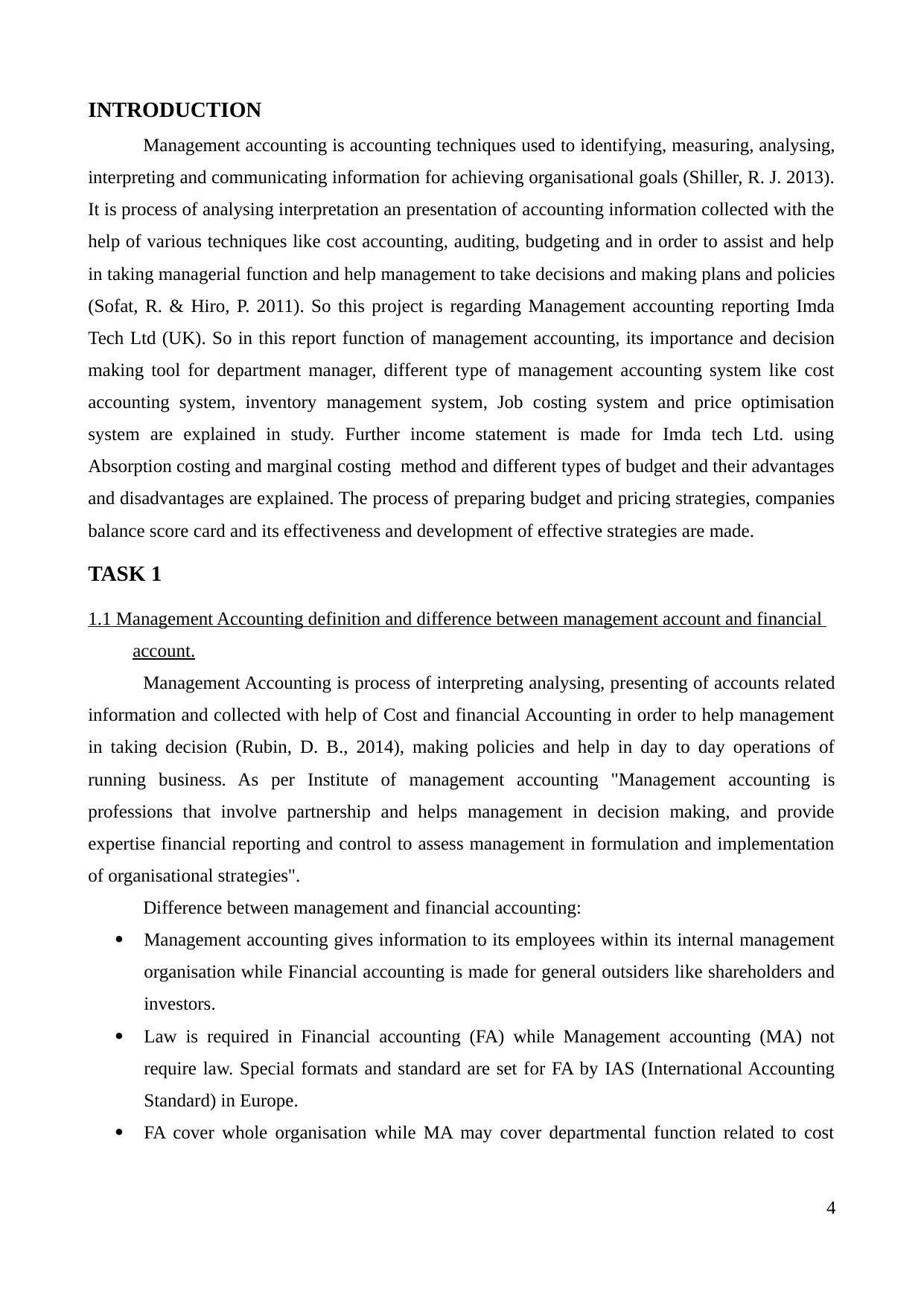
INTRODUCTION
Management accounting is accounting techniques used to identifying, measuring, analysing,
interpreting and communicating information for achieving organisational goals (Shiller, R. J. 2013).
It is process of analysing interpretation an presentation of accounting information collected with the
help of various techniques like cost accounting, auditing, budgeting and in order to assist and help
in taking managerial function and help management to take decisions and making plans and policies
(Sofat, R. & Hiro, P. 2011). So this project is regarding Management accounting reporting Imda
Tech Ltd (UK). So in this report function of management accounting, its importance and decision
making tool for department manager, different type of management accounting system like cost
accounting system, inventory management system, Job costing system and price optimisation
system are explained in study. Further income statement is made for Imda tech Ltd. using
Absorption costing and marginal costing method and different types of budget and their advantages
and disadvantages are explained. The process of preparing budget and pricing strategies, companies
balance score card and its effectiveness and development of effective strategies are made.
TASK 1
1.1 Management Accounting definition and difference between management account and financial
account.
Management Accounting is process of interpreting analysing, presenting of accounts related
information and collected with help of Cost and financial Accounting in order to help management
in taking decision (Rubin, D. B., 2014), making policies and help in day to day operations of
running business. As per Institute of management accounting "Management accounting is
professions that involve partnership and helps management in decision making, and provide
expertise financial reporting and control to assess management in formulation and implementation
of organisational strategies".
Difference between management and financial accounting:
Management accounting gives information to its employees within its internal management
organisation while Financial accounting is made for general outsiders like shareholders and
investors.
Law is required in Financial accounting (FA) while Management accounting (MA) not
require law. Special formats and standard are set for FA by IAS (International Accounting
Standard) in Europe.
FA cover whole organisation while MA may cover departmental function related to cost
4
Management accounting is accounting techniques used to identifying, measuring, analysing,
interpreting and communicating information for achieving organisational goals (Shiller, R. J. 2013).
It is process of analysing interpretation an presentation of accounting information collected with the
help of various techniques like cost accounting, auditing, budgeting and in order to assist and help
in taking managerial function and help management to take decisions and making plans and policies
(Sofat, R. & Hiro, P. 2011). So this project is regarding Management accounting reporting Imda
Tech Ltd (UK). So in this report function of management accounting, its importance and decision
making tool for department manager, different type of management accounting system like cost
accounting system, inventory management system, Job costing system and price optimisation
system are explained in study. Further income statement is made for Imda tech Ltd. using
Absorption costing and marginal costing method and different types of budget and their advantages
and disadvantages are explained. The process of preparing budget and pricing strategies, companies
balance score card and its effectiveness and development of effective strategies are made.
TASK 1
1.1 Management Accounting definition and difference between management account and financial
account.
Management Accounting is process of interpreting analysing, presenting of accounts related
information and collected with help of Cost and financial Accounting in order to help management
in taking decision (Rubin, D. B., 2014), making policies and help in day to day operations of
running business. As per Institute of management accounting "Management accounting is
professions that involve partnership and helps management in decision making, and provide
expertise financial reporting and control to assess management in formulation and implementation
of organisational strategies".
Difference between management and financial accounting:
Management accounting gives information to its employees within its internal management
organisation while Financial accounting is made for general outsiders like shareholders and
investors.
Law is required in Financial accounting (FA) while Management accounting (MA) not
require law. Special formats and standard are set for FA by IAS (International Accounting
Standard) in Europe.
FA cover whole organisation while MA may cover departmental function related to cost
4
Paraphrase This Document
Need a fresh take? Get an instant paraphrase of this document with our AI Paraphraser
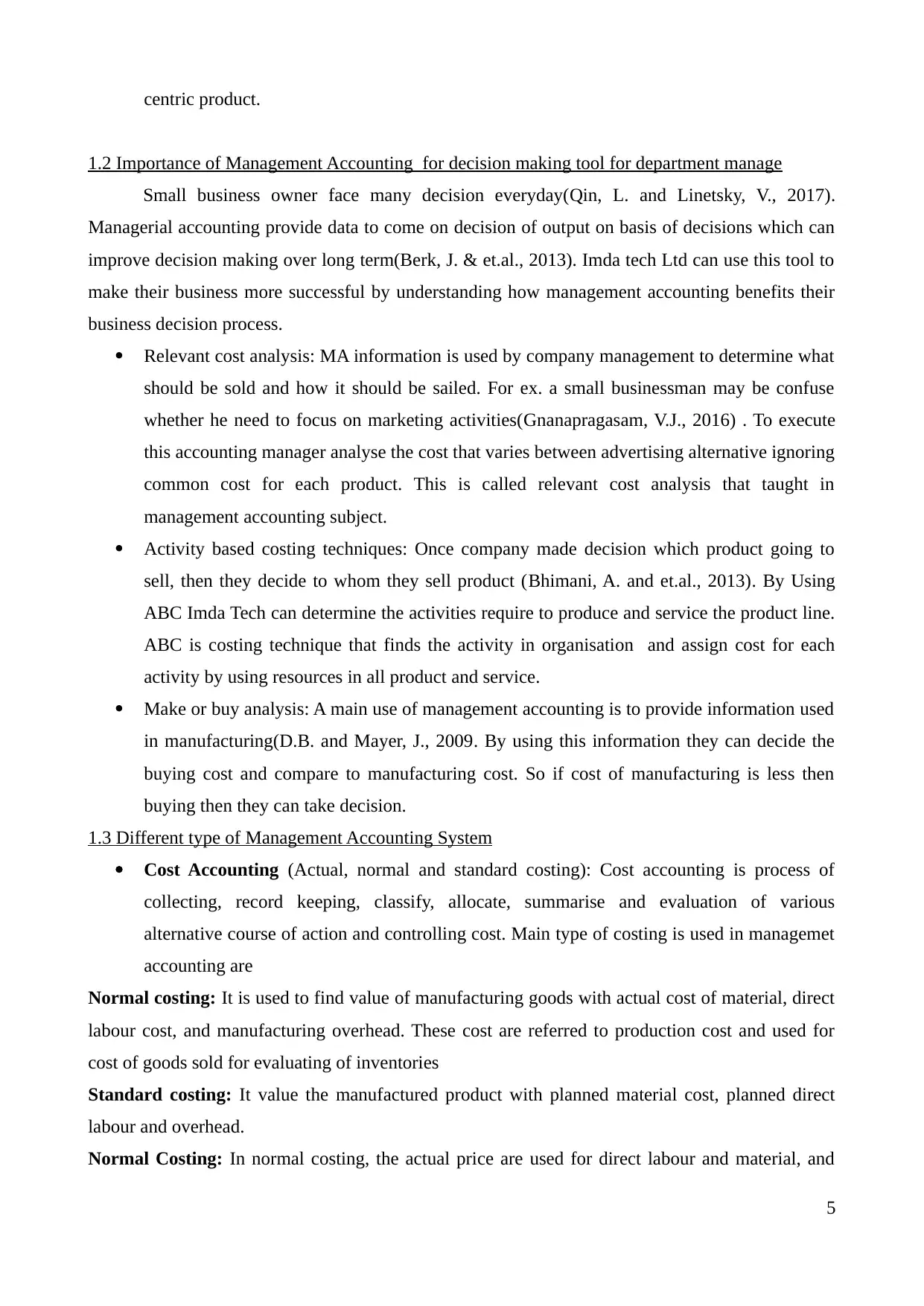
centric product.
1.2 Importance of Management Accounting for decision making tool for department manage
Small business owner face many decision everyday(Qin, L. and Linetsky, V., 2017).
Managerial accounting provide data to come on decision of output on basis of decisions which can
improve decision making over long term(Berk, J. & et.al., 2013). Imda tech Ltd can use this tool to
make their business more successful by understanding how management accounting benefits their
business decision process.
Relevant cost analysis: MA information is used by company management to determine what
should be sold and how it should be sailed. For ex. a small businessman may be confuse
whether he need to focus on marketing activities(Gnanapragasam, V.J., 2016) . To execute
this accounting manager analyse the cost that varies between advertising alternative ignoring
common cost for each product. This is called relevant cost analysis that taught in
management accounting subject.
Activity based costing techniques: Once company made decision which product going to
sell, then they decide to whom they sell product (Bhimani, A. and et.al., 2013). By Using
ABC Imda Tech can determine the activities require to produce and service the product line.
ABC is costing technique that finds the activity in organisation and assign cost for each
activity by using resources in all product and service.
Make or buy analysis: A main use of management accounting is to provide information used
in manufacturing(D.B. and Mayer, J., 2009. By using this information they can decide the
buying cost and compare to manufacturing cost. So if cost of manufacturing is less then
buying then they can take decision.
1.3 Different type of Management Accounting System
Cost Accounting (Actual, normal and standard costing): Cost accounting is process of
collecting, record keeping, classify, allocate, summarise and evaluation of various
alternative course of action and controlling cost. Main type of costing is used in managemet
accounting are
Normal costing: It is used to find value of manufacturing goods with actual cost of material, direct
labour cost, and manufacturing overhead. These cost are referred to production cost and used for
cost of goods sold for evaluating of inventories
Standard costing: It value the manufactured product with planned material cost, planned direct
labour and overhead.
Normal Costing: In normal costing, the actual price are used for direct labour and material, and
5
1.2 Importance of Management Accounting for decision making tool for department manage
Small business owner face many decision everyday(Qin, L. and Linetsky, V., 2017).
Managerial accounting provide data to come on decision of output on basis of decisions which can
improve decision making over long term(Berk, J. & et.al., 2013). Imda tech Ltd can use this tool to
make their business more successful by understanding how management accounting benefits their
business decision process.
Relevant cost analysis: MA information is used by company management to determine what
should be sold and how it should be sailed. For ex. a small businessman may be confuse
whether he need to focus on marketing activities(Gnanapragasam, V.J., 2016) . To execute
this accounting manager analyse the cost that varies between advertising alternative ignoring
common cost for each product. This is called relevant cost analysis that taught in
management accounting subject.
Activity based costing techniques: Once company made decision which product going to
sell, then they decide to whom they sell product (Bhimani, A. and et.al., 2013). By Using
ABC Imda Tech can determine the activities require to produce and service the product line.
ABC is costing technique that finds the activity in organisation and assign cost for each
activity by using resources in all product and service.
Make or buy analysis: A main use of management accounting is to provide information used
in manufacturing(D.B. and Mayer, J., 2009. By using this information they can decide the
buying cost and compare to manufacturing cost. So if cost of manufacturing is less then
buying then they can take decision.
1.3 Different type of Management Accounting System
Cost Accounting (Actual, normal and standard costing): Cost accounting is process of
collecting, record keeping, classify, allocate, summarise and evaluation of various
alternative course of action and controlling cost. Main type of costing is used in managemet
accounting are
Normal costing: It is used to find value of manufacturing goods with actual cost of material, direct
labour cost, and manufacturing overhead. These cost are referred to production cost and used for
cost of goods sold for evaluating of inventories
Standard costing: It value the manufactured product with planned material cost, planned direct
labour and overhead.
Normal Costing: In normal costing, the actual price are used for direct labour and material, and
5
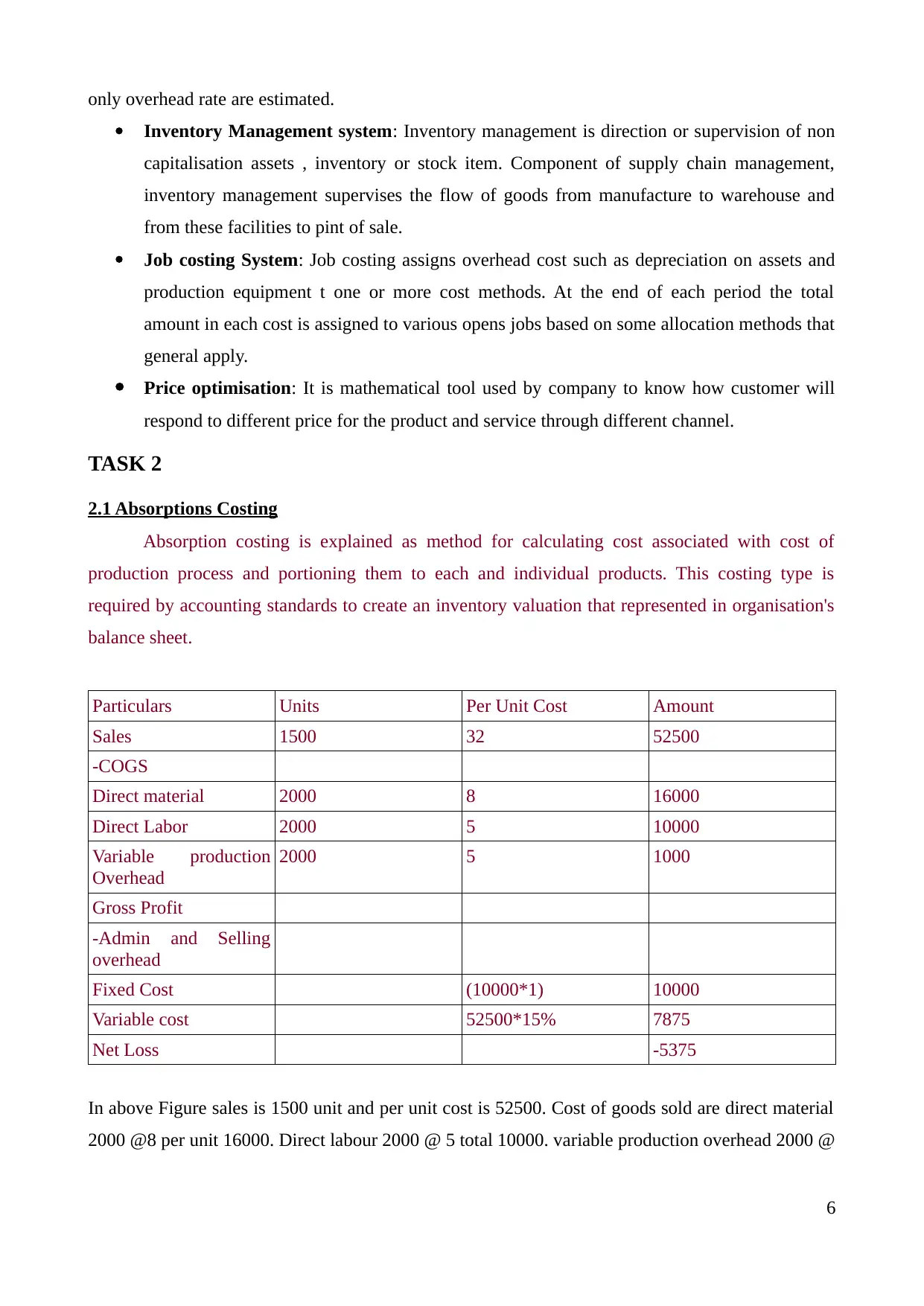
only overhead rate are estimated.
Inventory Management system: Inventory management is direction or supervision of non
capitalisation assets , inventory or stock item. Component of supply chain management,
inventory management supervises the flow of goods from manufacture to warehouse and
from these facilities to pint of sale.
Job costing System: Job costing assigns overhead cost such as depreciation on assets and
production equipment t one or more cost methods. At the end of each period the total
amount in each cost is assigned to various opens jobs based on some allocation methods that
general apply.
Price optimisation: It is mathematical tool used by company to know how customer will
respond to different price for the product and service through different channel.
TASK 2
2.1 Absorptions Costing
Absorption costing is explained as method for calculating cost associated with cost of
production process and portioning them to each and individual products. This costing type is
required by accounting standards to create an inventory valuation that represented in organisation's
balance sheet.
Particulars Units Per Unit Cost Amount
Sales 1500 32 52500
-COGS
Direct material 2000 8 16000
Direct Labor 2000 5 10000
Variable production
Overhead
2000 5 1000
Gross Profit
-Admin and Selling
overhead
Fixed Cost (10000*1) 10000
Variable cost 52500*15% 7875
Net Loss -5375
In above Figure sales is 1500 unit and per unit cost is 52500. Cost of goods sold are direct material
2000 @8 per unit 16000. Direct labour 2000 @ 5 total 10000. variable production overhead 2000 @
6
Inventory Management system: Inventory management is direction or supervision of non
capitalisation assets , inventory or stock item. Component of supply chain management,
inventory management supervises the flow of goods from manufacture to warehouse and
from these facilities to pint of sale.
Job costing System: Job costing assigns overhead cost such as depreciation on assets and
production equipment t one or more cost methods. At the end of each period the total
amount in each cost is assigned to various opens jobs based on some allocation methods that
general apply.
Price optimisation: It is mathematical tool used by company to know how customer will
respond to different price for the product and service through different channel.
TASK 2
2.1 Absorptions Costing
Absorption costing is explained as method for calculating cost associated with cost of
production process and portioning them to each and individual products. This costing type is
required by accounting standards to create an inventory valuation that represented in organisation's
balance sheet.
Particulars Units Per Unit Cost Amount
Sales 1500 32 52500
-COGS
Direct material 2000 8 16000
Direct Labor 2000 5 10000
Variable production
Overhead
2000 5 1000
Gross Profit
-Admin and Selling
overhead
Fixed Cost (10000*1) 10000
Variable cost 52500*15% 7875
Net Loss -5375
In above Figure sales is 1500 unit and per unit cost is 52500. Cost of goods sold are direct material
2000 @8 per unit 16000. Direct labour 2000 @ 5 total 10000. variable production overhead 2000 @
6
⊘ This is a preview!⊘
Do you want full access?
Subscribe today to unlock all pages.

Trusted by 1+ million students worldwide
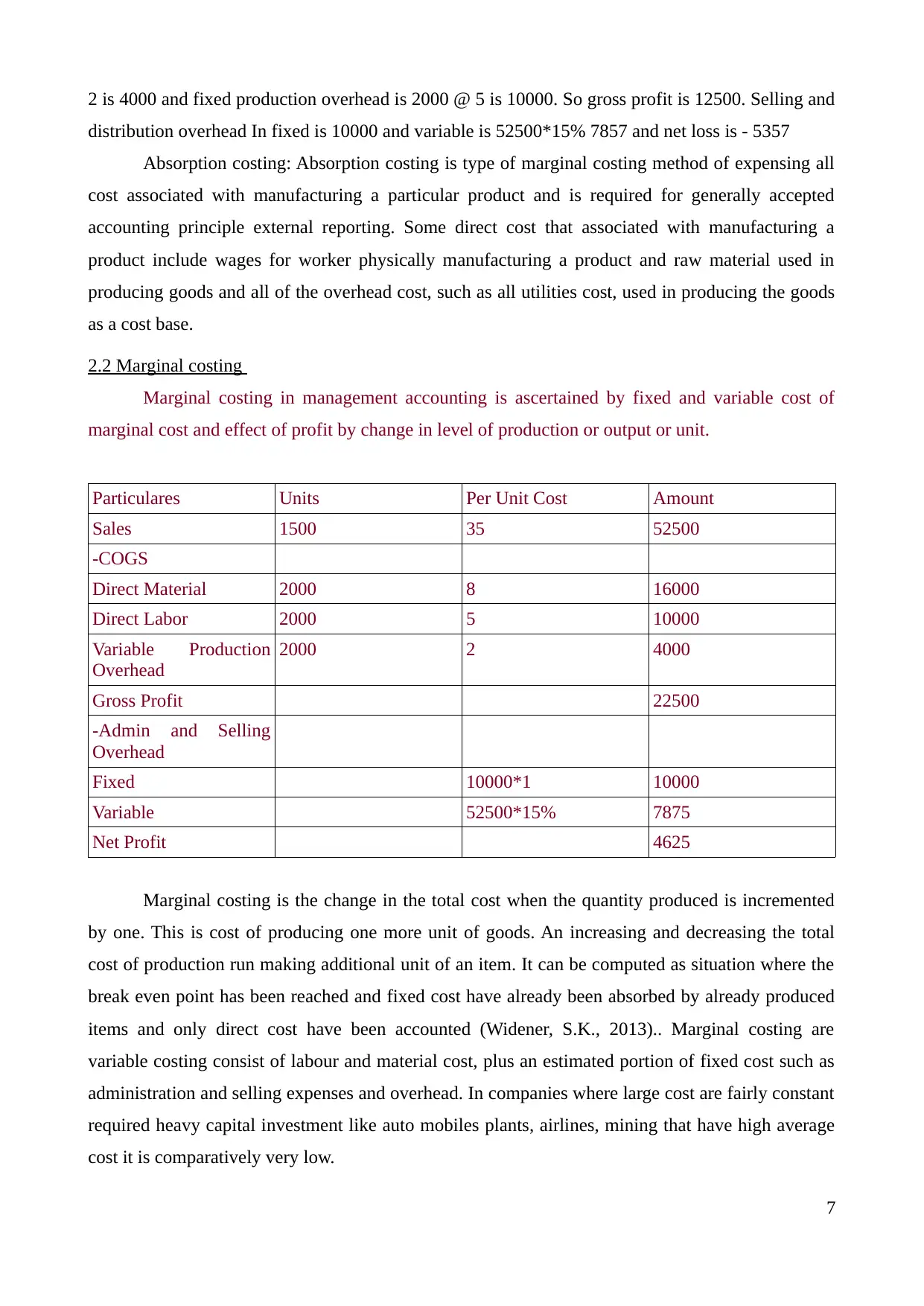
2 is 4000 and fixed production overhead is 2000 @ 5 is 10000. So gross profit is 12500. Selling and
distribution overhead In fixed is 10000 and variable is 52500*15% 7857 and net loss is - 5357
Absorption costing: Absorption costing is type of marginal costing method of expensing all
cost associated with manufacturing a particular product and is required for generally accepted
accounting principle external reporting. Some direct cost that associated with manufacturing a
product include wages for worker physically manufacturing a product and raw material used in
producing goods and all of the overhead cost, such as all utilities cost, used in producing the goods
as a cost base.
2.2 Marginal costing
Marginal costing in management accounting is ascertained by fixed and variable cost of
marginal cost and effect of profit by change in level of production or output or unit.
Particulares Units Per Unit Cost Amount
Sales 1500 35 52500
-COGS
Direct Material 2000 8 16000
Direct Labor 2000 5 10000
Variable Production
Overhead
2000 2 4000
Gross Profit 22500
-Admin and Selling
Overhead
Fixed 10000*1 10000
Variable 52500*15% 7875
Net Profit 4625
Marginal costing is the change in the total cost when the quantity produced is incremented
by one. This is cost of producing one more unit of goods. An increasing and decreasing the total
cost of production run making additional unit of an item. It can be computed as situation where the
break even point has been reached and fixed cost have already been absorbed by already produced
items and only direct cost have been accounted (Widener, S.K., 2013).. Marginal costing are
variable costing consist of labour and material cost, plus an estimated portion of fixed cost such as
administration and selling expenses and overhead. In companies where large cost are fairly constant
required heavy capital investment like auto mobiles plants, airlines, mining that have high average
cost it is comparatively very low.
7
distribution overhead In fixed is 10000 and variable is 52500*15% 7857 and net loss is - 5357
Absorption costing: Absorption costing is type of marginal costing method of expensing all
cost associated with manufacturing a particular product and is required for generally accepted
accounting principle external reporting. Some direct cost that associated with manufacturing a
product include wages for worker physically manufacturing a product and raw material used in
producing goods and all of the overhead cost, such as all utilities cost, used in producing the goods
as a cost base.
2.2 Marginal costing
Marginal costing in management accounting is ascertained by fixed and variable cost of
marginal cost and effect of profit by change in level of production or output or unit.
Particulares Units Per Unit Cost Amount
Sales 1500 35 52500
-COGS
Direct Material 2000 8 16000
Direct Labor 2000 5 10000
Variable Production
Overhead
2000 2 4000
Gross Profit 22500
-Admin and Selling
Overhead
Fixed 10000*1 10000
Variable 52500*15% 7875
Net Profit 4625
Marginal costing is the change in the total cost when the quantity produced is incremented
by one. This is cost of producing one more unit of goods. An increasing and decreasing the total
cost of production run making additional unit of an item. It can be computed as situation where the
break even point has been reached and fixed cost have already been absorbed by already produced
items and only direct cost have been accounted (Widener, S.K., 2013).. Marginal costing are
variable costing consist of labour and material cost, plus an estimated portion of fixed cost such as
administration and selling expenses and overhead. In companies where large cost are fairly constant
required heavy capital investment like auto mobiles plants, airlines, mining that have high average
cost it is comparatively very low.
7
Paraphrase This Document
Need a fresh take? Get an instant paraphrase of this document with our AI Paraphraser
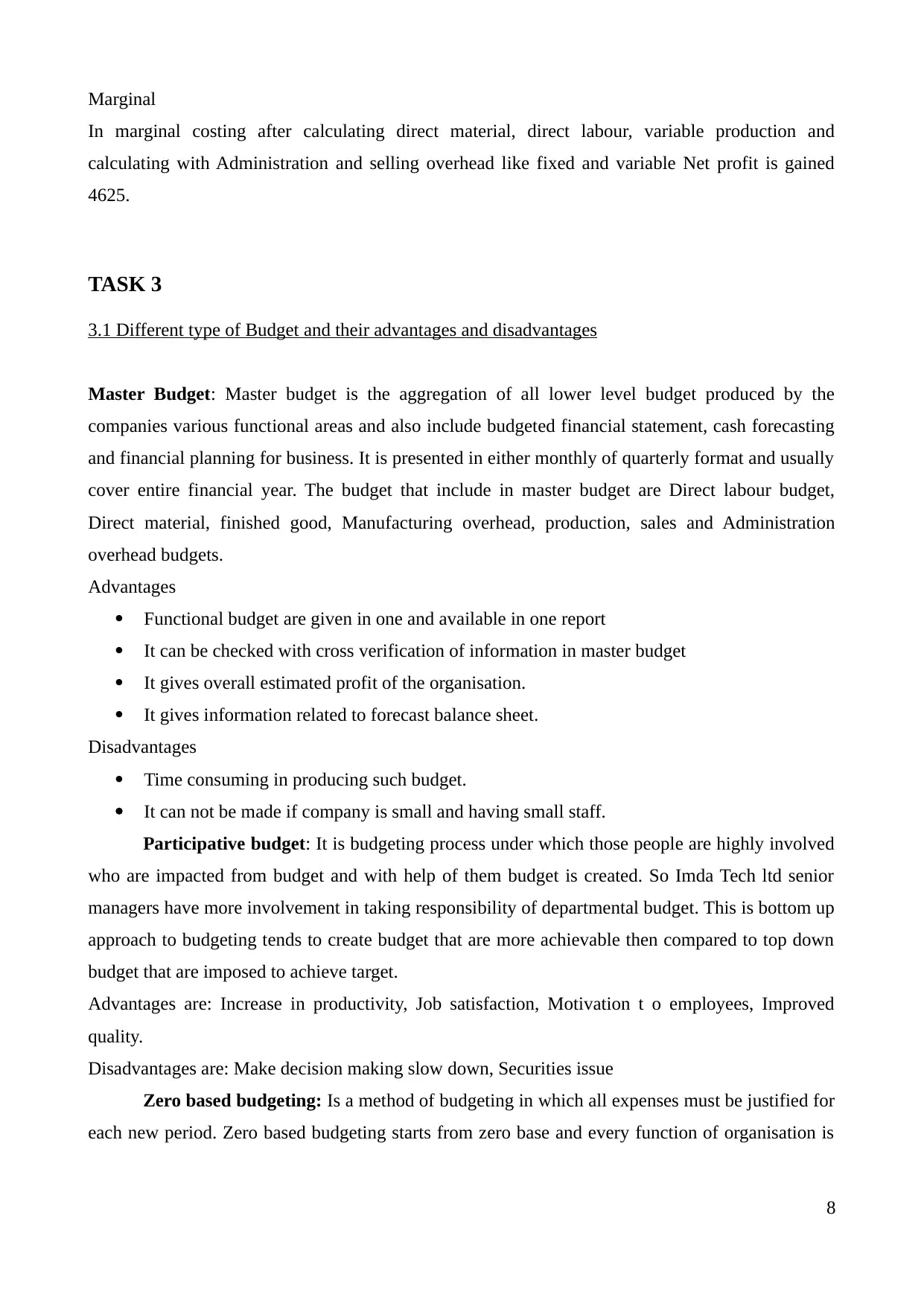
Marginal
In marginal costing after calculating direct material, direct labour, variable production and
calculating with Administration and selling overhead like fixed and variable Net profit is gained
4625.
TASK 3
3.1 Different type of Budget and their advantages and disadvantages
Master Budget: Master budget is the aggregation of all lower level budget produced by the
companies various functional areas and also include budgeted financial statement, cash forecasting
and financial planning for business. It is presented in either monthly of quarterly format and usually
cover entire financial year. The budget that include in master budget are Direct labour budget,
Direct material, finished good, Manufacturing overhead, production, sales and Administration
overhead budgets.
Advantages
Functional budget are given in one and available in one report
It can be checked with cross verification of information in master budget
It gives overall estimated profit of the organisation.
It gives information related to forecast balance sheet.
Disadvantages
Time consuming in producing such budget.
It can not be made if company is small and having small staff.
Participative budget: It is budgeting process under which those people are highly involved
who are impacted from budget and with help of them budget is created. So Imda Tech ltd senior
managers have more involvement in taking responsibility of departmental budget. This is bottom up
approach to budgeting tends to create budget that are more achievable then compared to top down
budget that are imposed to achieve target.
Advantages are: Increase in productivity, Job satisfaction, Motivation t o employees, Improved
quality.
Disadvantages are: Make decision making slow down, Securities issue
Zero based budgeting: Is a method of budgeting in which all expenses must be justified for
each new period. Zero based budgeting starts from zero base and every function of organisation is
8
In marginal costing after calculating direct material, direct labour, variable production and
calculating with Administration and selling overhead like fixed and variable Net profit is gained
4625.
TASK 3
3.1 Different type of Budget and their advantages and disadvantages
Master Budget: Master budget is the aggregation of all lower level budget produced by the
companies various functional areas and also include budgeted financial statement, cash forecasting
and financial planning for business. It is presented in either monthly of quarterly format and usually
cover entire financial year. The budget that include in master budget are Direct labour budget,
Direct material, finished good, Manufacturing overhead, production, sales and Administration
overhead budgets.
Advantages
Functional budget are given in one and available in one report
It can be checked with cross verification of information in master budget
It gives overall estimated profit of the organisation.
It gives information related to forecast balance sheet.
Disadvantages
Time consuming in producing such budget.
It can not be made if company is small and having small staff.
Participative budget: It is budgeting process under which those people are highly involved
who are impacted from budget and with help of them budget is created. So Imda Tech ltd senior
managers have more involvement in taking responsibility of departmental budget. This is bottom up
approach to budgeting tends to create budget that are more achievable then compared to top down
budget that are imposed to achieve target.
Advantages are: Increase in productivity, Job satisfaction, Motivation t o employees, Improved
quality.
Disadvantages are: Make decision making slow down, Securities issue
Zero based budgeting: Is a method of budgeting in which all expenses must be justified for
each new period. Zero based budgeting starts from zero base and every function of organisation is
8
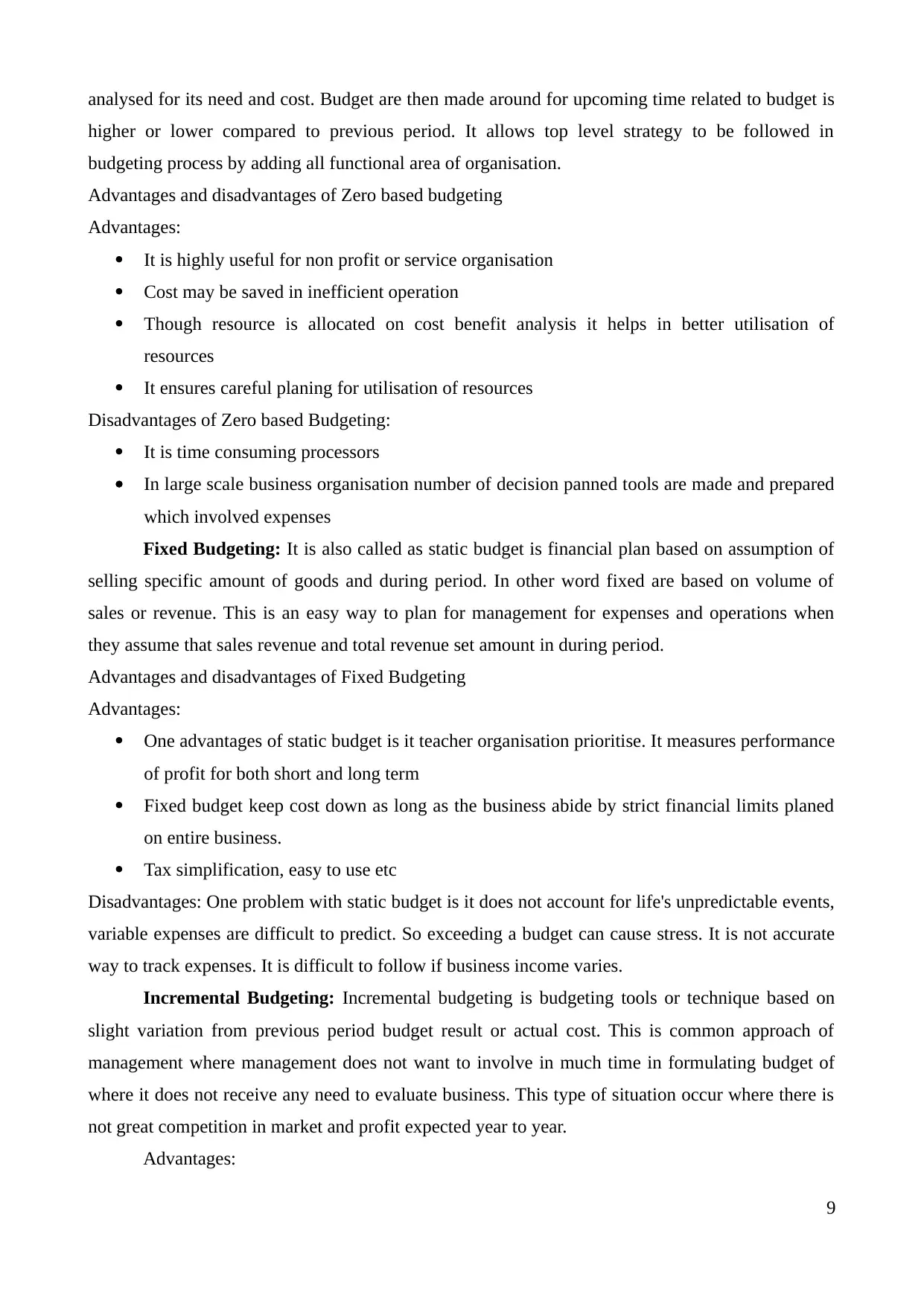
analysed for its need and cost. Budget are then made around for upcoming time related to budget is
higher or lower compared to previous period. It allows top level strategy to be followed in
budgeting process by adding all functional area of organisation.
Advantages and disadvantages of Zero based budgeting
Advantages:
It is highly useful for non profit or service organisation
Cost may be saved in inefficient operation
Though resource is allocated on cost benefit analysis it helps in better utilisation of
resources
It ensures careful planing for utilisation of resources
Disadvantages of Zero based Budgeting:
It is time consuming processors
In large scale business organisation number of decision panned tools are made and prepared
which involved expenses
Fixed Budgeting: It is also called as static budget is financial plan based on assumption of
selling specific amount of goods and during period. In other word fixed are based on volume of
sales or revenue. This is an easy way to plan for management for expenses and operations when
they assume that sales revenue and total revenue set amount in during period.
Advantages and disadvantages of Fixed Budgeting
Advantages:
One advantages of static budget is it teacher organisation prioritise. It measures performance
of profit for both short and long term
Fixed budget keep cost down as long as the business abide by strict financial limits planed
on entire business.
Tax simplification, easy to use etc
Disadvantages: One problem with static budget is it does not account for life's unpredictable events,
variable expenses are difficult to predict. So exceeding a budget can cause stress. It is not accurate
way to track expenses. It is difficult to follow if business income varies.
Incremental Budgeting: Incremental budgeting is budgeting tools or technique based on
slight variation from previous period budget result or actual cost. This is common approach of
management where management does not want to involve in much time in formulating budget of
where it does not receive any need to evaluate business. This type of situation occur where there is
not great competition in market and profit expected year to year.
Advantages:
9
higher or lower compared to previous period. It allows top level strategy to be followed in
budgeting process by adding all functional area of organisation.
Advantages and disadvantages of Zero based budgeting
Advantages:
It is highly useful for non profit or service organisation
Cost may be saved in inefficient operation
Though resource is allocated on cost benefit analysis it helps in better utilisation of
resources
It ensures careful planing for utilisation of resources
Disadvantages of Zero based Budgeting:
It is time consuming processors
In large scale business organisation number of decision panned tools are made and prepared
which involved expenses
Fixed Budgeting: It is also called as static budget is financial plan based on assumption of
selling specific amount of goods and during period. In other word fixed are based on volume of
sales or revenue. This is an easy way to plan for management for expenses and operations when
they assume that sales revenue and total revenue set amount in during period.
Advantages and disadvantages of Fixed Budgeting
Advantages:
One advantages of static budget is it teacher organisation prioritise. It measures performance
of profit for both short and long term
Fixed budget keep cost down as long as the business abide by strict financial limits planed
on entire business.
Tax simplification, easy to use etc
Disadvantages: One problem with static budget is it does not account for life's unpredictable events,
variable expenses are difficult to predict. So exceeding a budget can cause stress. It is not accurate
way to track expenses. It is difficult to follow if business income varies.
Incremental Budgeting: Incremental budgeting is budgeting tools or technique based on
slight variation from previous period budget result or actual cost. This is common approach of
management where management does not want to involve in much time in formulating budget of
where it does not receive any need to evaluate business. This type of situation occur where there is
not great competition in market and profit expected year to year.
Advantages:
9
⊘ This is a preview!⊘
Do you want full access?
Subscribe today to unlock all pages.

Trusted by 1+ million students worldwide
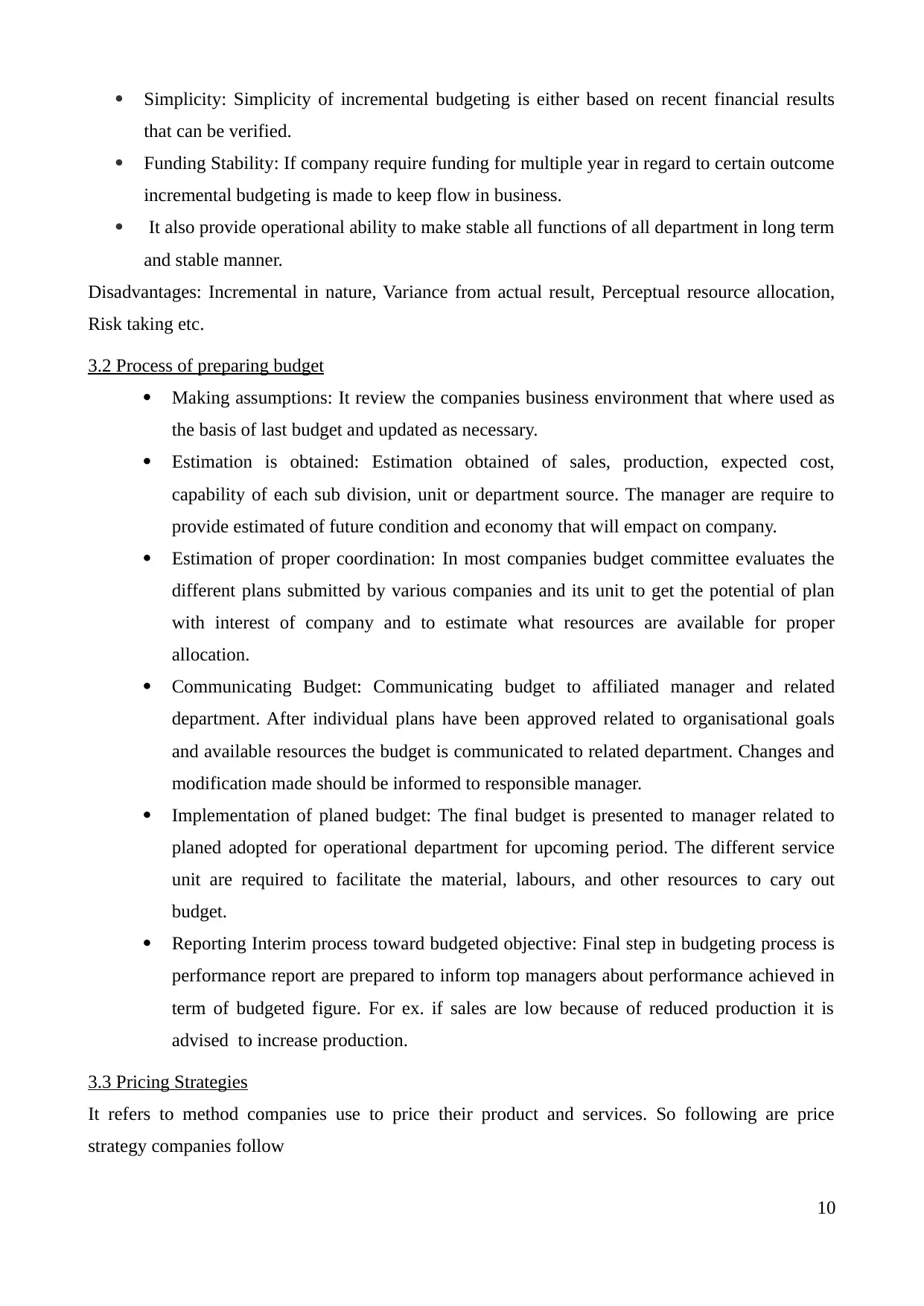
Simplicity: Simplicity of incremental budgeting is either based on recent financial results
that can be verified.
Funding Stability: If company require funding for multiple year in regard to certain outcome
incremental budgeting is made to keep flow in business.
It also provide operational ability to make stable all functions of all department in long term
and stable manner.
Disadvantages: Incremental in nature, Variance from actual result, Perceptual resource allocation,
Risk taking etc.
3.2 Process of preparing budget
Making assumptions: It review the companies business environment that where used as
the basis of last budget and updated as necessary.
Estimation is obtained: Estimation obtained of sales, production, expected cost,
capability of each sub division, unit or department source. The manager are require to
provide estimated of future condition and economy that will empact on company.
Estimation of proper coordination: In most companies budget committee evaluates the
different plans submitted by various companies and its unit to get the potential of plan
with interest of company and to estimate what resources are available for proper
allocation.
Communicating Budget: Communicating budget to affiliated manager and related
department. After individual plans have been approved related to organisational goals
and available resources the budget is communicated to related department. Changes and
modification made should be informed to responsible manager.
Implementation of planed budget: The final budget is presented to manager related to
planed adopted for operational department for upcoming period. The different service
unit are required to facilitate the material, labours, and other resources to cary out
budget.
Reporting Interim process toward budgeted objective: Final step in budgeting process is
performance report are prepared to inform top managers about performance achieved in
term of budgeted figure. For ex. if sales are low because of reduced production it is
advised to increase production.
3.3 Pricing Strategies
It refers to method companies use to price their product and services. So following are price
strategy companies follow
10
that can be verified.
Funding Stability: If company require funding for multiple year in regard to certain outcome
incremental budgeting is made to keep flow in business.
It also provide operational ability to make stable all functions of all department in long term
and stable manner.
Disadvantages: Incremental in nature, Variance from actual result, Perceptual resource allocation,
Risk taking etc.
3.2 Process of preparing budget
Making assumptions: It review the companies business environment that where used as
the basis of last budget and updated as necessary.
Estimation is obtained: Estimation obtained of sales, production, expected cost,
capability of each sub division, unit or department source. The manager are require to
provide estimated of future condition and economy that will empact on company.
Estimation of proper coordination: In most companies budget committee evaluates the
different plans submitted by various companies and its unit to get the potential of plan
with interest of company and to estimate what resources are available for proper
allocation.
Communicating Budget: Communicating budget to affiliated manager and related
department. After individual plans have been approved related to organisational goals
and available resources the budget is communicated to related department. Changes and
modification made should be informed to responsible manager.
Implementation of planed budget: The final budget is presented to manager related to
planed adopted for operational department for upcoming period. The different service
unit are required to facilitate the material, labours, and other resources to cary out
budget.
Reporting Interim process toward budgeted objective: Final step in budgeting process is
performance report are prepared to inform top managers about performance achieved in
term of budgeted figure. For ex. if sales are low because of reduced production it is
advised to increase production.
3.3 Pricing Strategies
It refers to method companies use to price their product and services. So following are price
strategy companies follow
10
Paraphrase This Document
Need a fresh take? Get an instant paraphrase of this document with our AI Paraphraser
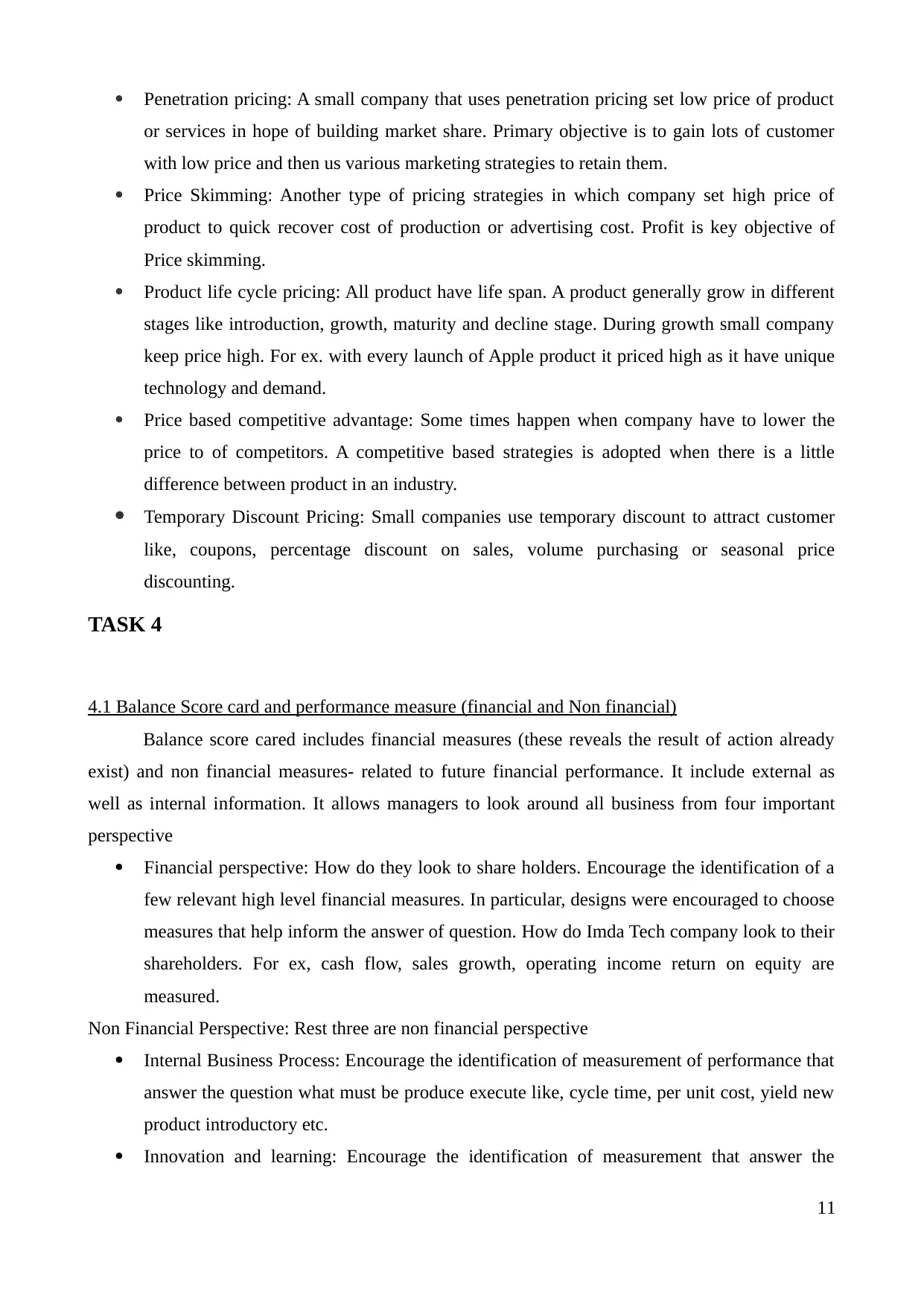
Penetration pricing: A small company that uses penetration pricing set low price of product
or services in hope of building market share. Primary objective is to gain lots of customer
with low price and then us various marketing strategies to retain them.
Price Skimming: Another type of pricing strategies in which company set high price of
product to quick recover cost of production or advertising cost. Profit is key objective of
Price skimming.
Product life cycle pricing: All product have life span. A product generally grow in different
stages like introduction, growth, maturity and decline stage. During growth small company
keep price high. For ex. with every launch of Apple product it priced high as it have unique
technology and demand.
Price based competitive advantage: Some times happen when company have to lower the
price to of competitors. A competitive based strategies is adopted when there is a little
difference between product in an industry.
Temporary Discount Pricing: Small companies use temporary discount to attract customer
like, coupons, percentage discount on sales, volume purchasing or seasonal price
discounting.
TASK 4
4.1 Balance Score card and performance measure (financial and Non financial)
Balance score cared includes financial measures (these reveals the result of action already
exist) and non financial measures- related to future financial performance. It include external as
well as internal information. It allows managers to look around all business from four important
perspective
Financial perspective: How do they look to share holders. Encourage the identification of a
few relevant high level financial measures. In particular, designs were encouraged to choose
measures that help inform the answer of question. How do Imda Tech company look to their
shareholders. For ex, cash flow, sales growth, operating income return on equity are
measured.
Non Financial Perspective: Rest three are non financial perspective
Internal Business Process: Encourage the identification of measurement of performance that
answer the question what must be produce execute like, cycle time, per unit cost, yield new
product introductory etc.
Innovation and learning: Encourage the identification of measurement that answer the
11
or services in hope of building market share. Primary objective is to gain lots of customer
with low price and then us various marketing strategies to retain them.
Price Skimming: Another type of pricing strategies in which company set high price of
product to quick recover cost of production or advertising cost. Profit is key objective of
Price skimming.
Product life cycle pricing: All product have life span. A product generally grow in different
stages like introduction, growth, maturity and decline stage. During growth small company
keep price high. For ex. with every launch of Apple product it priced high as it have unique
technology and demand.
Price based competitive advantage: Some times happen when company have to lower the
price to of competitors. A competitive based strategies is adopted when there is a little
difference between product in an industry.
Temporary Discount Pricing: Small companies use temporary discount to attract customer
like, coupons, percentage discount on sales, volume purchasing or seasonal price
discounting.
TASK 4
4.1 Balance Score card and performance measure (financial and Non financial)
Balance score cared includes financial measures (these reveals the result of action already
exist) and non financial measures- related to future financial performance. It include external as
well as internal information. It allows managers to look around all business from four important
perspective
Financial perspective: How do they look to share holders. Encourage the identification of a
few relevant high level financial measures. In particular, designs were encouraged to choose
measures that help inform the answer of question. How do Imda Tech company look to their
shareholders. For ex, cash flow, sales growth, operating income return on equity are
measured.
Non Financial Perspective: Rest three are non financial perspective
Internal Business Process: Encourage the identification of measurement of performance that
answer the question what must be produce execute like, cycle time, per unit cost, yield new
product introductory etc.
Innovation and learning: Encourage the identification of measurement that answer the
11
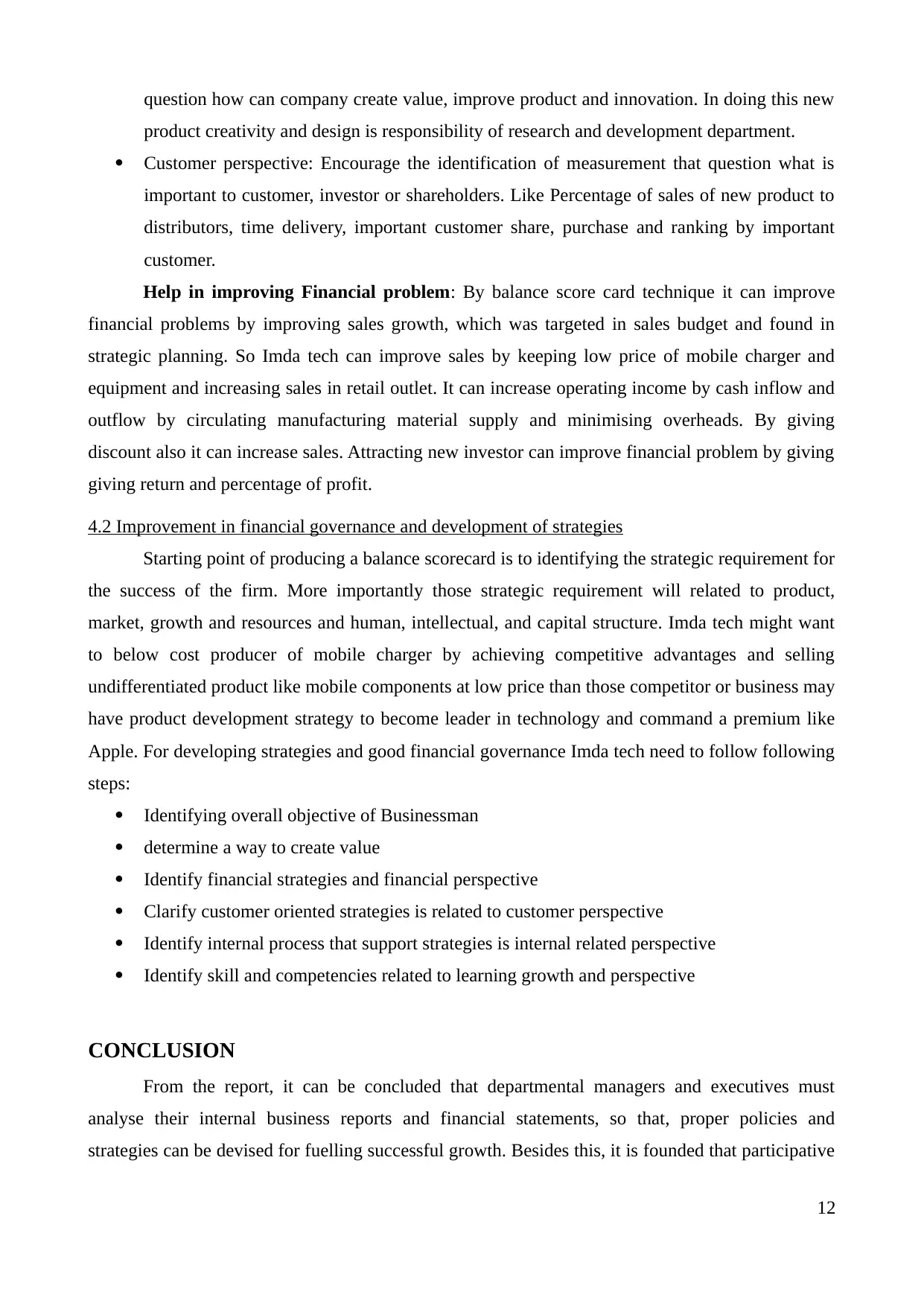
question how can company create value, improve product and innovation. In doing this new
product creativity and design is responsibility of research and development department.
Customer perspective: Encourage the identification of measurement that question what is
important to customer, investor or shareholders. Like Percentage of sales of new product to
distributors, time delivery, important customer share, purchase and ranking by important
customer.
Help in improving Financial problem: By balance score card technique it can improve
financial problems by improving sales growth, which was targeted in sales budget and found in
strategic planning. So Imda tech can improve sales by keeping low price of mobile charger and
equipment and increasing sales in retail outlet. It can increase operating income by cash inflow and
outflow by circulating manufacturing material supply and minimising overheads. By giving
discount also it can increase sales. Attracting new investor can improve financial problem by giving
giving return and percentage of profit.
4.2 Improvement in financial governance and development of strategies
Starting point of producing a balance scorecard is to identifying the strategic requirement for
the success of the firm. More importantly those strategic requirement will related to product,
market, growth and resources and human, intellectual, and capital structure. Imda tech might want
to below cost producer of mobile charger by achieving competitive advantages and selling
undifferentiated product like mobile components at low price than those competitor or business may
have product development strategy to become leader in technology and command a premium like
Apple. For developing strategies and good financial governance Imda tech need to follow following
steps:
Identifying overall objective of Businessman
determine a way to create value
Identify financial strategies and financial perspective
Clarify customer oriented strategies is related to customer perspective
Identify internal process that support strategies is internal related perspective
Identify skill and competencies related to learning growth and perspective
CONCLUSION
From the report, it can be concluded that departmental managers and executives must
analyse their internal business reports and financial statements, so that, proper policies and
strategies can be devised for fuelling successful growth. Besides this, it is founded that participative
12
product creativity and design is responsibility of research and development department.
Customer perspective: Encourage the identification of measurement that question what is
important to customer, investor or shareholders. Like Percentage of sales of new product to
distributors, time delivery, important customer share, purchase and ranking by important
customer.
Help in improving Financial problem: By balance score card technique it can improve
financial problems by improving sales growth, which was targeted in sales budget and found in
strategic planning. So Imda tech can improve sales by keeping low price of mobile charger and
equipment and increasing sales in retail outlet. It can increase operating income by cash inflow and
outflow by circulating manufacturing material supply and minimising overheads. By giving
discount also it can increase sales. Attracting new investor can improve financial problem by giving
giving return and percentage of profit.
4.2 Improvement in financial governance and development of strategies
Starting point of producing a balance scorecard is to identifying the strategic requirement for
the success of the firm. More importantly those strategic requirement will related to product,
market, growth and resources and human, intellectual, and capital structure. Imda tech might want
to below cost producer of mobile charger by achieving competitive advantages and selling
undifferentiated product like mobile components at low price than those competitor or business may
have product development strategy to become leader in technology and command a premium like
Apple. For developing strategies and good financial governance Imda tech need to follow following
steps:
Identifying overall objective of Businessman
determine a way to create value
Identify financial strategies and financial perspective
Clarify customer oriented strategies is related to customer perspective
Identify internal process that support strategies is internal related perspective
Identify skill and competencies related to learning growth and perspective
CONCLUSION
From the report, it can be concluded that departmental managers and executives must
analyse their internal business reports and financial statements, so that, proper policies and
strategies can be devised for fuelling successful growth. Besides this, it is founded that participative
12
⊘ This is a preview!⊘
Do you want full access?
Subscribe today to unlock all pages.

Trusted by 1+ million students worldwide
1 out of 14
Related Documents
Your All-in-One AI-Powered Toolkit for Academic Success.
+13062052269
info@desklib.com
Available 24*7 on WhatsApp / Email
![[object Object]](/_next/static/media/star-bottom.7253800d.svg)
Unlock your academic potential
Copyright © 2020–2025 A2Z Services. All Rights Reserved. Developed and managed by ZUCOL.





